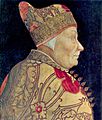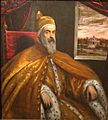Doge facts for kids
The word Doge (pronounced DOH-jeh) is an old Italian word that means "leader." It comes from the Latin word dux, which is also where the English word "duke" comes from.
A Doge was like an elected president or ruler in certain parts of Italy a long time ago. The most famous places that had a Doge were the cities of Venice and Genoa. These cities were powerful "republics," which means their leaders were chosen by people, not born into power like kings. They controlled important trade routes and lands, almost like small empires. Sometimes, a Doge would rule for their whole life, and other times, they would rule for a set number of years.
What Was a Doge?
A Doge was the highest official in some of the old Italian republics. Unlike kings or emperors who inherited their power, a Doge was chosen by a group of important citizens. This made the republics of Venice and Genoa unique for their time.
The Doge of Venice
The Republic of Venice was a very rich and powerful city-state built on water. It was known for its trade across the seas. The Doge of Venice was the leader of this republic for over 1,000 years, from the 8th century until 1797.
The Doge was elected by a complex system to make sure no single family became too powerful. Once elected, the Doge wore a special hat called the corno ducale. Even though the Doge was the head of state, their power was often limited by councils and laws. This was to prevent them from becoming a dictator. The Doge represented Venice in ceremonies and led its government.
The Doge of Genoa
Like Venice, Genoa was another important Italian city-state with a strong navy and trading empire. Genoa also had a Doge as its elected leader. The Doge of Genoa ruled from 1339 until 1797.
The role of the Doge in Genoa was similar to that in Venice. They were the chief executive and military leader. However, Genoa's political system was often more unstable than Venice's, with Doges sometimes being overthrown or ruling for shorter periods.
Images for kids
-
Leonardo Loredan (1501), Doge of Venice, painted by Giovanni Bellini. He is wearing the corno ducale, the ducal hat which symbolised his office.
-
Francesco Foscari, Doge of Venice (1423–1457) by Lazzaro Bastiani.
-
Portrait of Giovanni Mocenigo, Doge of Venice (1478–1485) by Gentile Bellini.
-
Francesco Erizzo, Doge of Venice (1631-1646) by Bernardo Strozzi.
-
Agostino Pallavicini, Doge of Genoa (1637-1639) by Anthony van Dyck.
See also
 In Spanish: Dux para niños
In Spanish: Dux para niños












